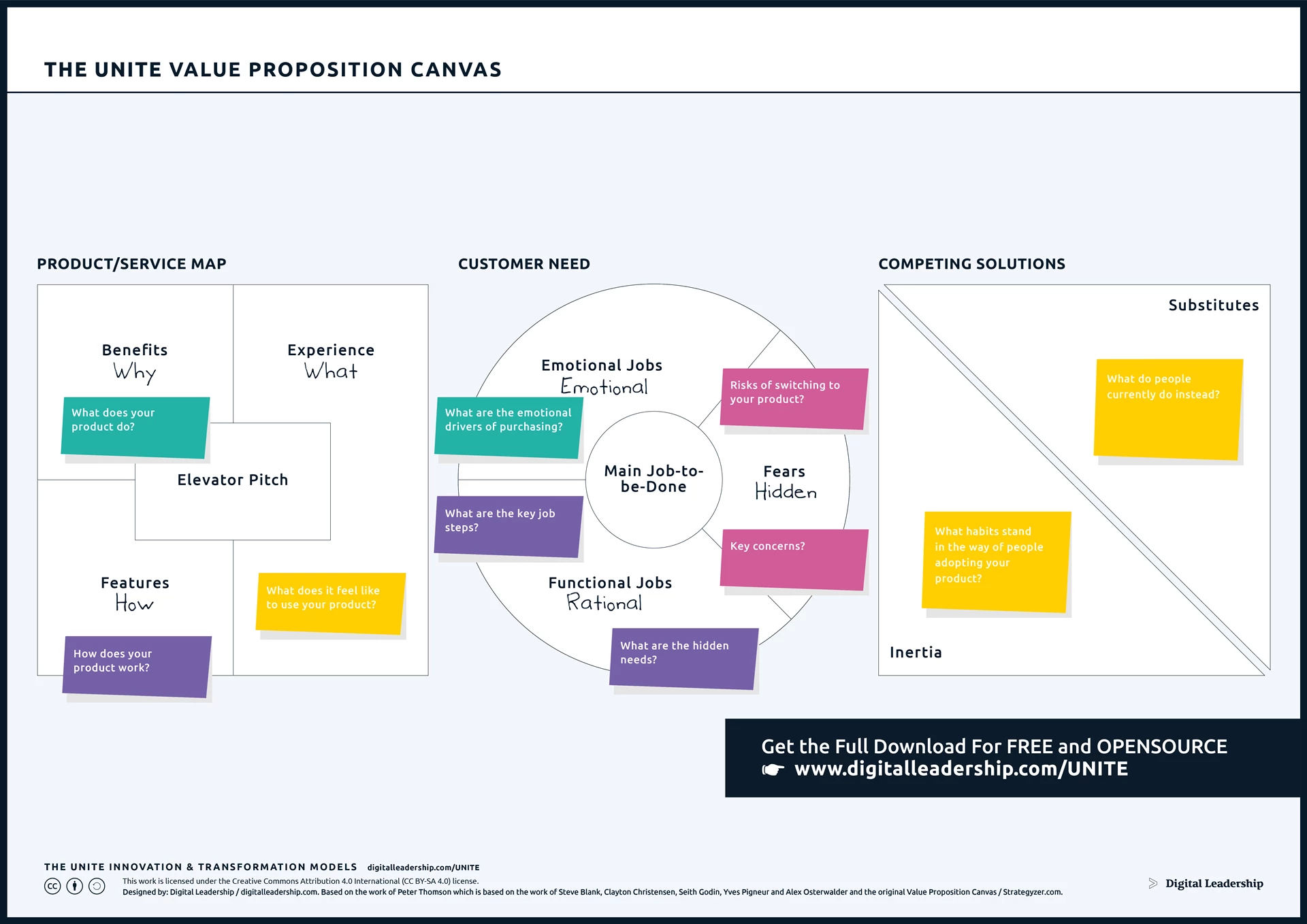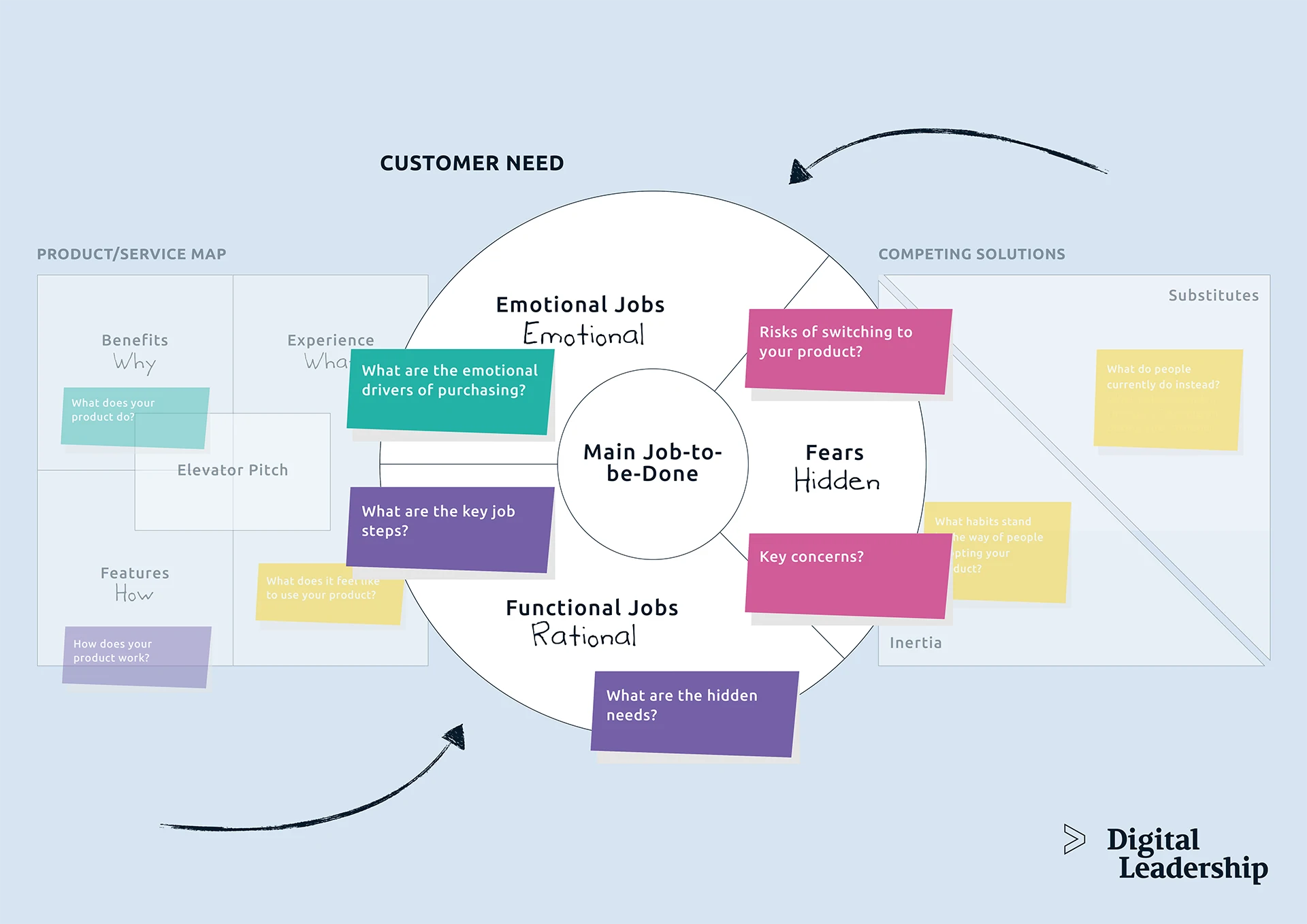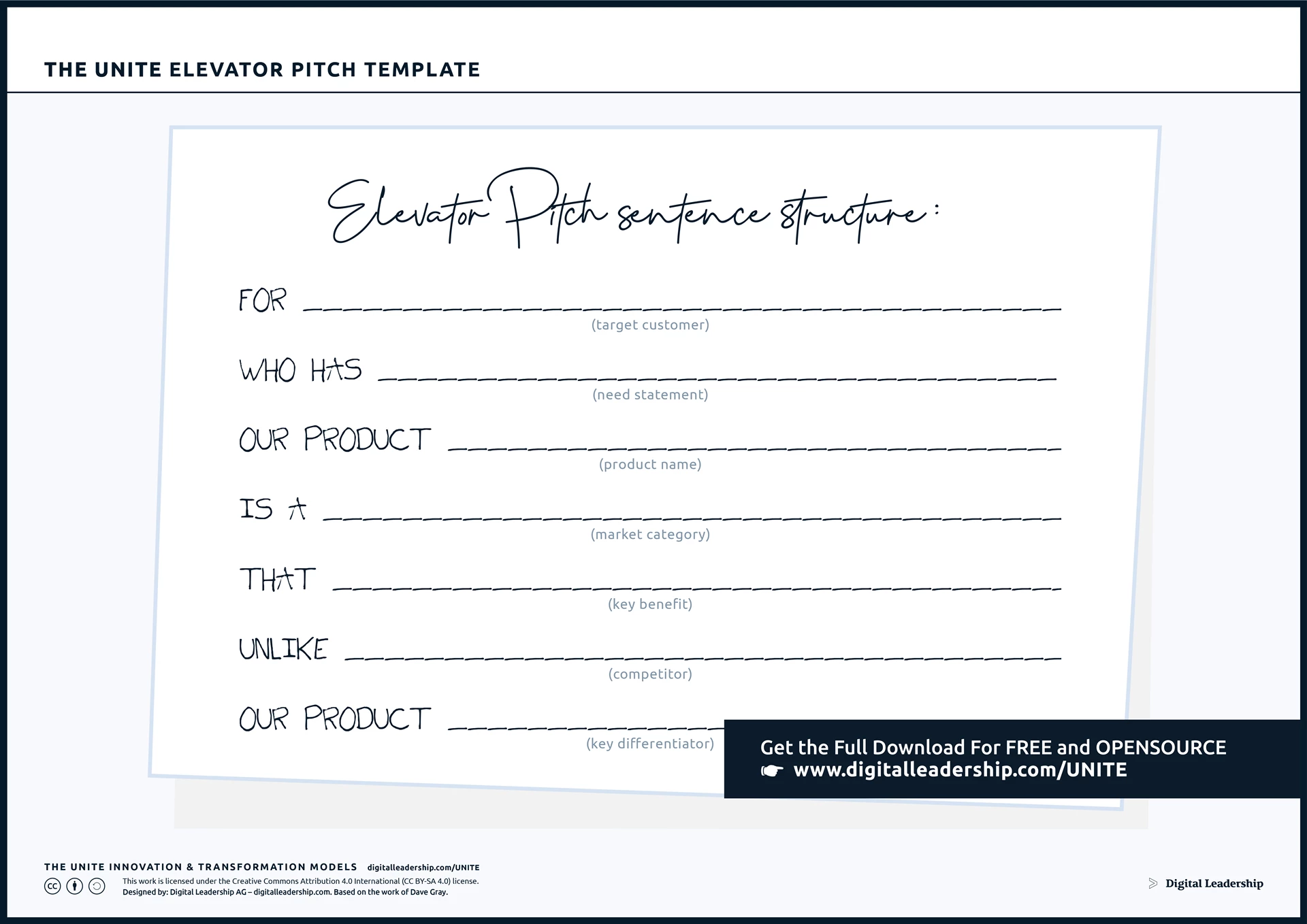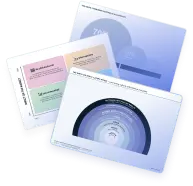How to Write a Value Proposition Template? – Our Full Guide With Examples
Published: 09 August, 2022
Business Models

Table of Contents
What is Value Proposition?
A Value Proposition is a statement that describes how a business brings value to a customer. To do so, the value proposition describes what the customer needs, what product or service is being offered, how that product or service addresses the need, and what makes this a unique value proposition or approach to the solution.
Value propositions are a thumbnail view of a company’s entire reason for being. Effective value propositions connect to the company’s mission statement clearly.
What Makes a Good Value Proposition?
Based on the clearly identified but underserved customer need, we want to create a Value Proposition (and prototype) that will directly solve it. In addition, we want to test the Value Proposition so that we are sure it does this job well.
A great Value Proposition needs to be embedded in a great Business Model to succeed; a good idea has never been enough. Some Business Models are superior to others by design. They will be harder to copy, will leverage exponential growth factors, will produce superior results, and will ultimately outperform competitors.
Related: The UNITE Value Proposition Canvas: The Beating Heart of the Business Model
Building on the lessons from hundreds of start-ups and innovations, we have put together a questionnaire that covers the most critical questions, allowing you to challenge your very own Business Model. Apply these twelve questions against each iteration of your Business Model to help you identify winning designs and gauge if you are making progress.
How do you use a Value Proposition Canvas?
We use the Value Proposition Canvas as a tool for understanding how what our company offers meets customers’ needs.

Designed by: Digital Leadership AG – Based on the work of Peter Thomson which is based on the work of Steve Blank, Clayton Christensen, Seith Godin, Yves Pigneur and Alex Osterwalder and the original Value Proposition Canvas
1- Create a Customer Profile
The Customer Profile we’ve developed draws on neurolinguistic programming and psychological research into motivation and choice architecture in order to focus in on the rational and emotional factors behind decision-making. Unlike some models of decision-making, it focuses less on a dichotomy between “pains” and “gains” because people can be motivated by pains and gains in different ways.
Related: Customer Pains and Gains: Understanding Your Customer Needs

- Customer Jobs to Be Done: What is the job the customer really wants to get done? The question JTBD asks is, why do your customers buy things from you? Do you think it is because you have the product with the highest specifications? Because you are the cheapest? Or is it due to your fantastic marketing department? Customers will buy from you if you understand and satisfy this need. We need to focus on the “job” a user has to accomplish, instead of whatever artificial market segment they belong to.
In an independent study of different innovation methods, Strategyn, one of the companies which have developed and led the Jobs-to-be-Done approach, found that the success rate of their JTBD innovation approach was 86% compared to the average success rate of traditional innovation methods, which was 17%. The relative success of JTBD should not come as a surprise; a targeted innovation approach naturally outperforms most ideation/luck-based methods. - Customer Fears: Although fear is a type of emotion, it so powerfully affects decision-making, that it is worthwhile to consider it separately. The dark side of making a decision is that it often carries the fear of giving up optionality. There is also fear of making a mistake, fear of missing out, fear of loss, and dozens of other related fears. Fears can be a strong driver of purchasing behaviour and can be the hidden source of wants and needs. Customer fears are often the secret reason that no one is buying your widget. For any product, there is a secret “switching pain.” Even if your product is better than the competition, it might not be a big enough improvement to overcome the inertia of the status quo.
- Emotional Jobs: The emotional drivers of decision-making are things that we want to be, do or have. Our emotional jobs are usually conscious (but aspirational) thoughts about how we would like to improve our lives. They sometimes seem like daydreams, but they can be powerful motivators of action. In this case, our desires are more abstract. I may need a car to get from point A to point B, but I want a BMW to demonstrate my success, social standing, or sense of taste. So, also consider emotional needs, such as self-actualization, social exchange/personal recognition, and security/risk reduction.
- Functional Jobs: The customer’s functional jobs are the rational things that the customer needs to get done. Interestingly, needs are not always conscious. Customers can have needs that they don’t know about. Designers call these “latent needs.” A great example is that many of us didn’t know we wanted to interact in real-time on digital platforms, sharing information with family and friends until we experienced social media (then, we all suddenly wanted to be on Facebook, Instagram, and others rather than using traditional forms of communication). The functional jobs speak more to rational motivations. Pay attention, there can be several functional jobs inherent in one Value Proposition.
At Digital Leadership, we understand the vital role that the customer journey plays in shaping your organization’s value proposition. We offer Customer Experience Consulting services to help businesses of all sizes and industries create exceptional customer experiences that are seamlessly integrated into their overall value proposition.
2- Map out the Value of your Product and Services
The Value Model is first of all defined by the Value Proposition(s) you offer. The Value Model also covers the supporting Product System, i.e., the complementary products and services which you offer in support of your core product. Think about accessories, related services and guarantees, and whatever allows you to up and cross-sell.
- Benefits: A benefit is what your product does for the customer and is the core of your VP. Benefits are the ways that the features make your customer’s life easier by solving their problem with a maximum amount of pleasure and a minimum amount of pain. The benefits of your product are the core of your value proposition. Begin by listing all the ways you can think of that your product would make your customer’s life better.
- Features: A feature is a detailed description of how your product works. Thus, here you should outline the functional attributes of your product. The features section should also describe why your customer should trust you (i.e., reasons to believe in your solution7). What makes you and your VP credible?
- Experience: The product experience is the way that owning your product makes the customer feel, the sum total of the combined features and benefits. Product experience is different from features and benefits, however, because it’s more about the emotional reasons why people buy your product and what it means in their lives. The product experience is the kernel that will allow you to elaborate on your market positioning and brand essence.
Elevator Pitch Template

Designed by: Digital Leadership AG – Based on the work of Dave Gray.
using an elevator pitch to shape your value proposition
An elevator pitch is useful when you’re in the start-up phase of your business, especially if you’re seeking investors and other partners. Additionally, an elevator pitch can help you form an effective value proposition by focusing on how you discuss your business activities.
Related: The UNITE Elevator Pitch Template
We suggest that you begin crafting your Elevator Pitch right away in order to give yourself an initial version to iterate (we love bad drafts!). Then, you can refine it as you go along. The Elevator Pitch follows a standard structure which will make your life easier.
The Elevator Pitch should neatly summarize your product, how it meets your customer’s needs, and how it differs from other possible solutions.
3- Analyze your Competing Solutions
Some companies claim that they have no direct competitors. However, the substitutes on the canvas aren’t just the obvious competitors. Instead, look for existing behaviours and coping mechanisms. How are people solving their JTBD right now?
The substitutes are worthwhile understanding in depth because they remind you that your customers are real people who have made it this far in their lives without your product. If your product is not sufficiently better than the existing solutions to overcome their resistance to switching, then you don’t have a real-world value proposition.
Elements of your Value Proposition Template
A strong value proposition can be useful for marketing campaigns. As such, we can think about value propositions in terms of marketing materials.
Imagine a brochure being mailed to potential customers or investors. How would your unique value proposition look on the page in the following format?
- Headline: a catchy but direct statement that connects the product with a solution to a common customer needs
- Sub Headline: tell the potential customer why your product is the best, even in a saturated market (what do you offer in terms of value that is an improvement over what is offered now? What if NOTHING is offered now?)
- Visual Element: the best value proposition examples have an image: a hero shot of the product or service being offered, concentrating on showing off the genuinely unique features of your product
Value Proposition Template Examples
As you’re working on writing your own value proposition template, it may be helpful to consult some value proposition examples.
While many business websites lean on the value propositions of famous enterprises, we thought we’d look at a few examples that are less well-known. You’ll see how vital these value propositions are to each of the companies’ overall business models.
More than 140 years after the first Sanders doors opened, we still believe in Fred’s simple mission to provide premium confections at a fair value. We use the finest real ingredients to make our products and never sacrifice quality to save on costs because confections shouldn’t only taste great, they should be made great!
Sanders Candy
You can see from this simple value proposition that Sanders, a candy company from Detroit, is selling its experience, its price point, and its commitment to quality. They also make a delicious bumpy cake!
The value proposition for Games Workshop can be assembled from four short statements on their website:
Games Workshop’s history stretches back over 40 years to humble origins as a UK-based mail-order business for fantasy roleplaying games. We make the best fantasy miniatures in the world, and a lot of them! Each Citadel miniature represents a unique character from our rich, evocative worlds. Quality is so important to us that every part of what we do is locally run from our campus in Nottingham, England – where we design, manufacture and ship our models.
Games Workshop
GW makes its money by selling games and the models necessary to play their games. Additionally, as you can see through the statement, they are a prime example of a value proposition including strong customer experience elements when they lean toward their “rich, evocative worlds.”
Perhaps IKEA is a more familiar company, with a compelling value proposition that’s focused on the power of well-designed products sold at competitive prices:
To offer a wide range of well-designed, functional home furnishing products at prices so low, that as many people as possible will be able to afford them.
IKEA
The German-based DIY store toom has a unique selling proposition that focuses on their dedication to wide product availability and access to expertise:
The success of toom DIY stores is based on a comprehensive concept that sets standards in the entire do-it-yourself sector. The range is primarily tailored to the needs and skills of experienced do-it-yourselfers and occasional do-it-yourselfers. In addition, toom combines the market-oriented range of products for everything to do with building, renovating and beautifying with extensive services. The toom specialist services for a change of scenery and craftsman service are unique in the industry and are characterized by a high level of advice and problem-solving expertise.
toom
Hopefully, those proposition examples serve as some guidance for how to write a value proposition for your unique situation. As you see, each of these value propositions speak directly to the concerns of their target audience to address pain points.
Each value proposition is a unique blend of product, price, experience, brand messaging, and competitive analysis to help the company stand out in a crowd. Additionally, these value propositions work very well to focus employee efforts. What’s important to a customer is important to the person helping meet the customer’s challenges through the company’s product.
How do you Write your Value Proposition?
While there are a number of ways to write a value proposition, we think there are some simple steps to follow. Successful value propositions–a value proposition statement, not necessarily the brand strategy and products themselves–are succinct and avoid unnecessary business jargon. Worry less about how, as singer “Weird” Al Yankovic sang, you’ll “Operationalize our strategies, Invest in world-class technology, And, leverage our core competencies, In order to holistically administrate, Exceptional synergy,” and focus more on the tangible actions you’ll take.
Step 1: Identify your Customer Jobs to Be Done
A complete customer profile will help you understand the needs of your target audience. Your Value Proposition should articulate a job your target customer needs completed.
Here is where you understand the outcome that customers expect. The best value propositions directly address clear customer jobs.
Related: Jobs to be Done Framework, Theory, Examples, and Statements JTBD
Step 2: Identify your Product’s Benefits and Values
Potential customers need to know what your product is. What are you selling?
Your value proposition must tell your target audience what you have for them: a thing to use, a service to lean on, technologies that make lives easier, etc.
Step 3: Connect your Customer JTBD with your Product Benefits
Bring Steps 1 and 2 together by explaining all the benefits of your product in terms of the customer’s pain points and customers’ needs. Think of Step 3 as a form of positioning statement; connect the key benefits of what you sell to the solution for your target customer and their needs.
Step 4: Differentiate Yourself from Competition
Given all the potential competitors in the world, explore why customers should choose your product over an alternative. A compelling value proposition uses several approaches to separate the company from others: competitive pricing, a better solution for a customer’s pain point, a better relative price, or some other specific element of your product that adds more or better value than the competition.
Related: Unfair Advantage: What is it, and how do you find yours?
Your marketing efforts grow out of a complete Step 4. Once you’ve written Step 4, your marketing messages can highlight the key differences between you and competitors.
If you’re looking for more specific language to use, consider this value proposition template that is common among business experts:
For [target customer] who [needs or wants SOMETHING], our [Services/Products] is [general category of product] that [list benefits].
Bringing the Value Proposition Home
As we hope you can see, a clear value proposition is extremely helpful, necessary really, if a business is hoping to succeed.
In closing, let’s consider the questions a value proposition statement should answer in the most overly simplistic terms:
- What are you selling?
- What does it do?
- Who is it for?
- How will potential customers use it?
- With as much competition as there is, why is yours the best?
Related: The UNITE Value Proposition Canvas: The Beating Heart of the Business Model
Articulate a clear value proposition as a means to test your idea, explain your unique selling proposition, and guide your business operations.
The experts at Digital Leadership would love to help you find your target buyer by working with you on your value proposition statement.
We recommend using a value proposition canvas as the beginning of understanding what exactly you’re offering. You’ll find that canvas, along with others, on this website, and in our book, How to Create Innovation.
Information about the book is also available on our website, and you can use the Contact links to reach out to everyone here at Digital Leadership.
The UNITE Business Model Framework
How to Create Innovation includes a number of canvases that focus on value creation and finding the right business model to meet your customer segment and customer needs. The framework is built to inspire drastic changes that help you find a competitive advantage. Our hope is that your company grows through business model innovation, and so we again encourage you to look deeper into our website and the book.
Here is a summary of the key ingredients of the framework:

Designed By: Digital Leadership AG
Business Models
The centrepiece is the Business Model Canvas, which covers the six main areas of a Business Model (the Operating, Value, Service, Experience, Cost, and Revenue Models).
The eXtended Business Model Canvas adds the immediate business context, including Business Drivers, customers, and the team, as well as the Unfair Advantage.
Detailed Models
A Business Model can be broken out into numerous aspects. Depending on what challenges you face, you can zoom in on your area of interest using an appropriate tool or canvas:
- Your Business Intention and objectives as well as your Massive Transformative Purpose summarize your drivers and give direction to what you do.
- The Value Proposition Canvas details the central components of your offering (the product or service).
- To dig into your Customer Segments, work with data-driven Personas.
- The JTBD Customer Job Statement and Job Map frame the JTBD of your customers.
- The Business Model Environment puts your Business Model in a market context composed of emerging trends and disruptive forces.
- The Innovation Culture Canvas helps you understand and consciously shape a culture that supports innovation.
- The Innovation team structure enables you to draft a team structure for your innovation initiative.
- Using learning and growth metrics, you can measure progress at the initial stages of development. These metrics help you focus on what really matters instead of creating a detailed business plan that will not really help you. Later on, you can expand the financial aspect of the Revenue and Cost Models with a full business case.
- The Operating Model Canvas helps you think through the Operating Model.


































 Book How to Create Innovation
Book How to Create Innovation